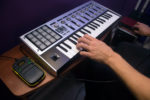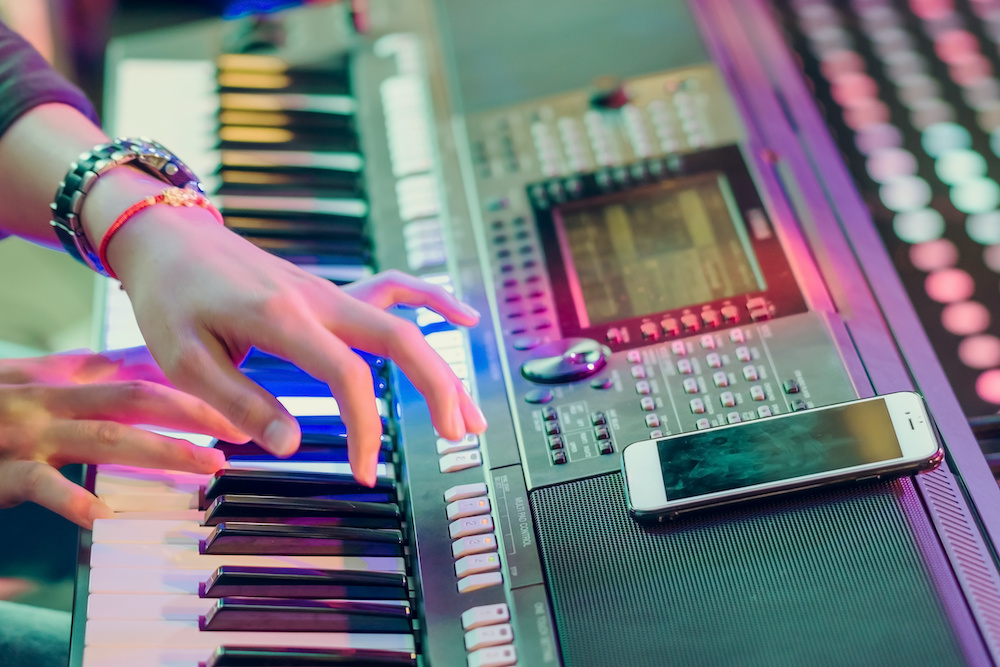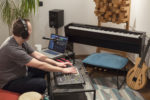How To Use a MIDI Keyboard: A Beginner’s Guide To Creating Music at Home

If you’re looking to get into audio production, you may be considering getting a MIDI keyboard.
“How to use a MIDI keyboard?” and “What is a MIDI keyboard?” are probably just some of the questions running through your head.
Is it easy? As a piano savant, do you think it would have the same feel as the real thing?
What features does it have? Is a MIDI keyboard necessary for a beginner?
Today, we’ll answer these questions and more to help you discover if there truly is a place for a MIDI keyboard in your musical journey.
How Do You Use a MIDI Keyboard?
There’s so much in music production you can explore with the help of a MIDI keyboard. In fact, seeing as you already know about this instrument, you’re probably familiar with its functions, to a certain extent.
As far as the answers to “What is a MIDI keyboard?” go, the basics are covered by the tool’s functions.
What Can You Do With MIDI?
In our quest to learn about MIDI, we realized that it might benefit readers to learn of what the instrument can do.
What the MIDI transports is strictly information. So, you won’t hear it make a single sound like a sampler or synthesizer.
It simply lacks the onboard sound source of these instruments to do so.
This further illuminates the MIDI’s role in music production.
If you’re using plugins in your digital audio workstation to compose music, the regions on the timeline that determine which notes are played by the plugins are the MIDI clips. They control when these notes are played, too.
When linking the keyboard to a DAW to play instruments, what you’re actually doing is feeding the device MIDI info in real-time.
The same thing occurs when you use your DAW to sequence MIDI and deliver the information to an external device like a drum machine, sampler, or synthesizer.
Note by note editing is where MIDI is unrivaled. It also allows you to change the articulation of performance or alter or replace the sounds being played in it.
Of course, that’s not even half of it. Notes aren’t the only elements you can control using the MIDI.
There are tons of other aspects in a musical production that have a MIDI equivalent.
Then, we have the changing of patches on software and hardware tools or effects or automating of parameters, which the tool also happens to be great at.
Image editing using MIDI is also possible.
Can You Use MIDI Keyboard Without Computer?
Even without a computer, you can still play your MIDI keyboard. Not having to purchase a new keyboard is certainly good news, isn’t it?
While this instrument is typically used in conjunction with tablets, smartphones, laptops, or personal computers, it happens that it can also be used without an accompanying device to create music.
Sometimes, people don’t have the time to learn about the device’s connectivity options.
Such is particularly the case for those who are new to keyboards.
So, MIDI keyboards don’t have to be attached to a computer to be played. However, they do have to be connected to something.
A controller alone won’t make any sound. You must attach it to a device that generates sound, which can be your computer or a synthesizer.
Speakers might also be needed. What isn’t needed is a computer; in fact, there are so many good substitutes for such an instrument.
Making Your Keyboard Sound Using an Affordable Option
Sometimes, solutions that don’t break the bank are what people look for when they practice with their MIDI keyboard.
The solution we’ll discuss today is one such that doesn’t require a computer for a person to practice on the go.
The first item you need to secure for this solution to work is a sound generator.
You can start things off on the most practical note by connecting your MIDI controller to a tone generator.
Here you’ll find a small module called the MIDI sound module, which serves as the USB port to connect your keyboard.
MIDI input is also preconfigured into this instrument in case your particular model lacks a USB slot and instead has a MIDI connection.
This box also happens to have an audio output. This is to allow you to connect either your speakers or headphones to the device.
So, you can clearly listen to what’s playing even while on the go. The presence of rechargeable batteries certainly don’t hurt, either, especially when they also do a great job of powering your keyboard.
In essence, this module allows you to utilize your keyboard even when there isn’t a computer in sight.
Since it’s a relatively small instrument, you can take it pretty much anywhere.
It also allows you to play quickly should you desire. Most think this is a great solution for those who want to practice their digital keyboard computer-less.

Is MIDI Keyboard Necessary?
Let’s get straight to the answer, shall we? Music existed before the MIDI keyboard and it will continue to exist long after it.
Even if we don’t go that far, people were still able to create great music with a regular computer keyboard, software, and mouse.
DAWs provide access to a “note view” feature that allows users to place notes one by one using their mouse.
In addition, more advanced DAWs, like the FL Studio 12, have a pre-configured feature that converts the standard computer keyboard into a virtual piano one.
We’re talking about the same keyboard for chatting and writing emails transformed into something that delivers MIDI information to a digital audio workstation. If that’s not cool, we don’t know what is.
For instance, your regular keyboard “Q” could be set to note F and the letter “W” could be used to represent note G, and so on.
That alone already allows you to play melodies via mapped keys.
By taking advantage of this DAW feature, you can turn your normal computer keyboard into something closely similar to a basic MIDI keyboard.
That tells you a MIDI keyboard isn’t necessary. You can create inspiring music even without the technological advantage afforded by the MIDI software.
Still, there is something about striking an actual keyboard that adds to the experience.
If this is what you’re after, then a MIDI keyboard may be necessary.
More Personalized Composition
With a MIDI controller, you give your compositions somewhat of a “human touch” that cannot be replicated by a standard computer keyboard and mouse.
This also serves as a good first step for users who eventually want to learn how to play an actual piano.
Better Quality and Efficiency
Now, if piano playing is something you don’t need help in, congrats to you! You’re a good way ahead of everyone else in the game.
Of course, in this scenario, a MIDI keyboard would be even more essential.
That’s because you’re already so far ahead in the musical journey that the basics alone will no longer cover the extent of your creative needs.
You need something that delivers quality and efficiency—something a regular computer keyboard can no longer provide.
The standard keyboard and mouse now makes the programming process tedious, which ruins the creative process altogether.
Also, if the feel of the piano keys really levels up the vibe, that’s what you need to strive for, regardless of the price.
When you consider the musical feedback and instant gratification a MIDI controller provides, then cost really is no object.
How To Select a Keyboard Controller
So, you’ve decided to finally get a digital piano keyboard. Good for you!
Number of Keys
The first thing you want to consider is the number of keys your keyboard should have.
You can choose one with 25, 49, 61, or 88 keys. These keys can also either be weighted, unweighted, or semi-weighted.
Then, there are programmable sliders, buttons, or knobs. Do you require aftertouch?
Price
Aside from answering these questions, there’s also the matter of the price.
The price range for these digital keyboards is from $80 to $700, depending on the device’s features and quality.
Basically, you can rely on this rule of thumb: the fewer features, the cheaper.
For a first-time buyer, it’s critical to begin at the lower end of the price spectrum.
You may be all excited now, but there’s a chance you may lose interest in the future.
Make sure you don’t end up breaking the bank for something you might get tired of in the next few months.
Conversely, if you’re a piano master who requires your keys to have the “right” feel and touch, then weighted keys might be your best option.
After all, they are as close as one can get to the real thing.
Granted, a keyboard with this set of keys can set you back several hundred bucks.
There are more than enough options to choose from. All you have to do is research.
How To Use a MIDI Keyboard Correctly: The Conclusion
If your musical journey is such that satisfaction can only be achieved with a MIDI keyboard, then make sure you know how to use a MIDI keyboard correctly.
This will allow you to create to your heart’s content programs that you can be proud of.
Sure, a standard computer keyboard and mouse may be sufficient for those who are unsure, but to someone who’s decided on becoming the best, a portable MIDI keyboard is a must-have.




